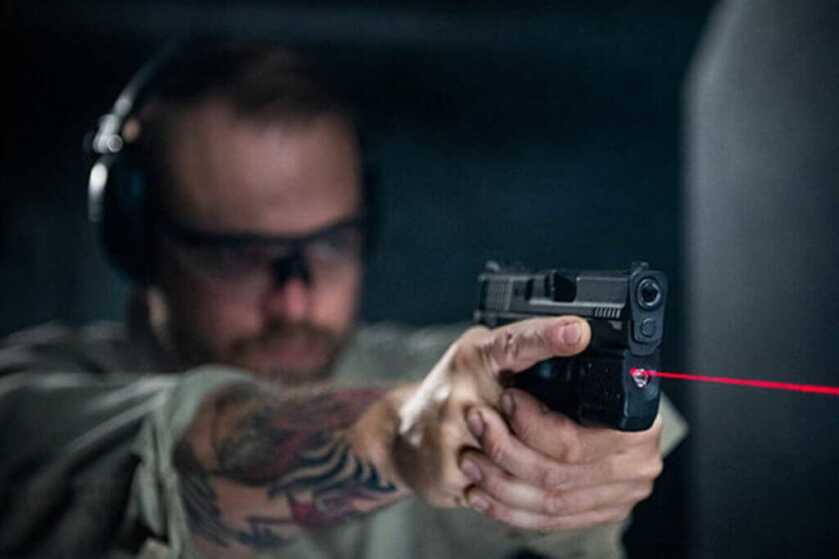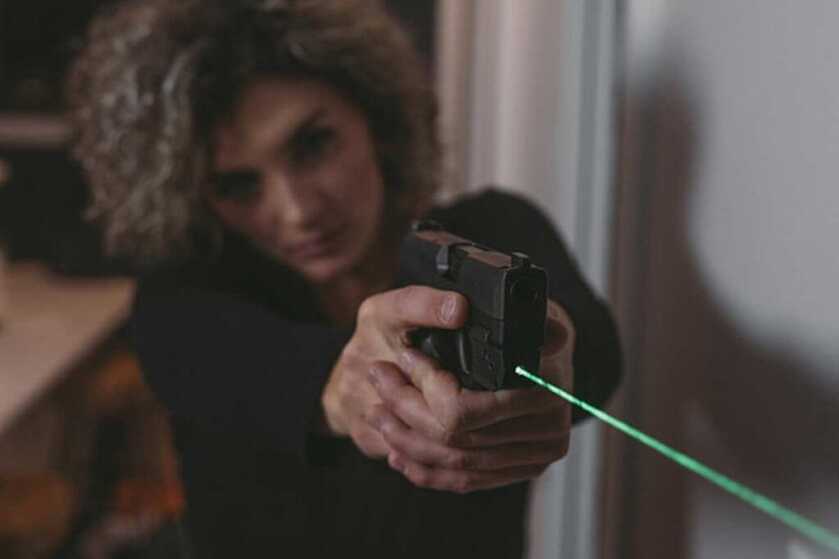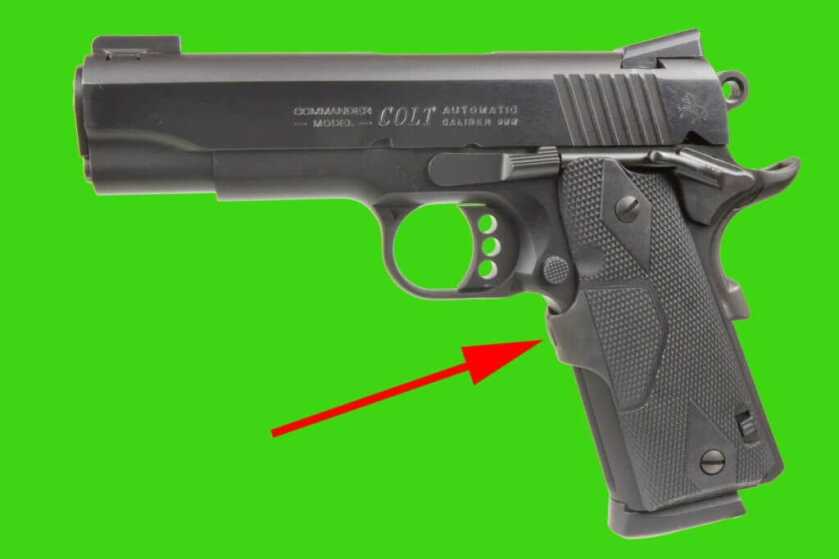LASERS ARE NO LONGER JUST A GIMMICK
There are credible stories around of a laser aiming device being pointed at a felonious aggressor and stopping an attack. For some reason, some bad guys see a dot dancing on their body and decide that they might get shot. Since they want to avoid that, they stop any criminal attack.
Part of the reason that bad guys stop attacking when a laser is activated is probably due to the movies and TV where a laser dot on a chest most often results in someone being shot. Whatever the reason, what started out as a gimmick and was a toy or movie prop are now serious aiming devices used by law enforcement, the military, and ordinary citizens.
There are many types of lasers available as aiming devices these days and many companies manufacture them. Some are better and more reliable than others, but generally speaking, if the laser is made by a major manufacturer, especially if it is used by law enforcement or the military, it is probably of good quality and will last.
There are basically two types of lasers visible to the naked eye. They are red and green in color. It used to be that the only available color was red, and that was because it was very difficult to build a reliable green laser that did not consume much more power. But thanks to technical advancements, green lasers are now in production and fairly common. Infrared (IR) lasers are also available, but are in use primarily by military units and require some type of night observation device – usually mounted on a helmet – we used to see them. They require specialized training and are not the subject of this article.

Is there any advantage to a green laser compared to a red one? That’s a good question. For some reason, the human eye is more sensitive to green light than red light. So, although red lasers can be useful, even in daylight, a green laser typically can be seen better meaning that the effective range is greater. So, many users have made the transition from red lasers to green lasers. But red lasers are still in wide use.
To effectively use a laser, training is a must. Yes, an untrained person can point a laser at a target, and if the laser is zeroed properly and the user can hold the gun steady enough, the bullet will hit that target. It is much harder though to do correctly than it sounds.

For one thing, the laser must be zeroed for a practical range. And that depends a lot on the type of gun used – a handgun or a rifle for our discussion – and how far away the laser on a target can be seen. Again, that varies with the color of the laser. Then there is the problem of how to zero the laser in relation to any other sights on the gun, and what the sight picture should look like.
Fortunately, training in the use of lasers is available for the average citizen and not just for military or law enforcement personnel. Regular readers of this series of The What & The Why articles will get tired of the mention of Gunsite Academy as a good training facility. But just like almost all things having to do with shooting, training and practice are necessary to do them effectively. And while there are other good training facilities and instructors around the country, Gunsite is the most prestigious and the oldest.
If you are still skeptical about the value of good training, take a look at a previous The What & The Why article on Instinctive Gun Handling. Pay particular attention to the experience of Marine Paul Gardner.
Anyway, Gunsite teamed with Crimson Trace, a leading manufacturer of laser aiming devices, to create a course to teach the proper use of lasers on both handguns and long guns. Military and law enforcement use them all the time.
Crimson Trace (CT) says that lasers help a shooter to be more effective in self-defense with a gun at close range, when moving, when time is short, and in darkness or low light. A laser can increase speed and accuracy, especially in a gunfight. But again, training is needed.
I had an interesting conversation about lasers with Charlie McNeese, a Rangemaster and longtime instructor at Gunsite who teaches, among other classes, the Crimson Trace laser course. And McNeese insists that a shooter must be competent with a handgun’s iron sights first before learning how to use a laser aiming device. By extension, this also applies to a long gun’s iron sights.
Although lasers these days are extremely reliable and the batteries that power them last a long time, lasers are still mechanical devices and can fail. Of course, they are likely to fail at the worst possible time which is in a fight for your life. So, the ability to transition instantly back to the gun’s iron sights is required.

But the average buyer of a laser looks at it as a crutch that eliminates the need to use iron sights at all. Because most people look for the easiest way to do something, they concentrate on using the laser instead of first learning how to use iron sights. At Gunsite, iron sights are used as backup sights in case the laser fails.
One of the reasons that the laser is so popular is that it is human nature to focus on the threat in a dangerous situation. So, the defender focuses on the assailant. But to use iron sights, the focus must be on the front sight, and that requires training. With the laser though, if it is properly zeroed, the focus can remain on the assailant while the laser is brought to that same place. Then, when the gun is fired, the bullet will strike where the laser is pointed. It is not quite as simple as it sounds though.

Most people who use a laser for the first time see the laser jerk around on the target, so they spend more time than necessary trying to get the laser to stop moving and stay in the exact spot they want to hit before firing. That wastes a lot of time and is not necessary.
It is nearly impossible to hold a gun steady on target without wobble unless the gun is rested on a bench. But about any hit within the vital zone, which on a felon is most often the center of the chest and is about eight inches in diameter, is satisfactory. A dead center hit in the vital zone is not necessary, so trying to get one is a waste of valuable time. But getting used to the wobble takes experience and training.
McNeese says it is important that the laser be immediately activated when the gun is aimed in a deadly force encounter. And for a handgun, the fastest and the most instinctive way of activating the laser is by the use of a button or switch that is located on the grip so that as soon as a firing grip is obtained, the laser goes on. At this point in time, Crimson Trace is the only manufacturer I am aware of that makes grip-activated lasers for handguns.

McNeese says time is wasted if a hand or a finger must be moved from a firing grip to find a switch located somewhere on the laser. It is much faster and automatic if the laser comes on when the handgun is gripped. And if the laser is on a long gun, he favors a pressure activated tape switch located where the gun is naturally gripped on the handguard or fore-end. That way, mere pressure on the switch activates the laser.
CT makes what is called a Lasergrip for handguns. When the gun is gripped naturally, the laser comes on, and carrying the gun does not require a special holster. If a laser is attached to the rail located beneath the barrel on the dust cover though, a holster that accommodates the laser is required. The laser does add weight to the front of the gun though which can help reduce muzzle flip and felt recoil. It seems there are pros and cons to most things.

Zeroing or sighting in a laser is not as simple as it sounds. No matter where the laser is located on the handgun or long gun, it will not be exactly where the bullet exits the barrel. It can’t be, so there is an offset. Then there is the question of the laser’s visibility. Even though a green laser is more visible, all lasers have their visual limitations depending on ambient lighting, atmospheric conditions, and distance to the target.
For a handgun, McNeese uses a 10 or 15 yard zero range, and for a long gun, 25 yards. But no matter the distance to the target, the bullet and the laser will meet at only one distance from the muzzle. At normal self-defense ranges though, the offset or distance between the point at which the laser hits the target and the point at which the bullet hits is so close that unless a particularly precision shot is needed, it makes no difference.
If the gun is equipped with iron sights, which is common with most handguns and long guns used for self-defense, Gunsite teaches that the laser dot should be just below the top of the front sight when the iron sights are properly aligned. McNeese says that doing so will result in the bullet impacting at the same place it would if the iron sights were used. This also results in a fast and easy transition to iron sights if the laser should fail. All the user needs to do to switch to the iron sights is lower the eye a fraction of an inch to align the iron sights properly. Other viable methods are used for zeroing a gun in relation to the iron sights, but again, this is the method taught by Gunsite.
Sometimes in a gunfight, the defender cannot properly line up his eye behind the iron sights. In this case, a properly zeroed laser can help because it can still be pointed at the target and the bullet will strike at that point. But lasers can be a liability because the laser can be a target locator. If an opponent cannot see from where shots are being fired, and if there is fog or smoke – any particulate matter – in the air, the laser beam can be seen and followed back to its source. Although the likelihood of this happening is low, it is a consideration. There are ways to minimize that risk that are taught at Gunsite though.
Whatever equipment is used, possessing it does not automatically make the person using it able to save a life. Having equipment without getting proper training may make the person dangerous to himself and others. So if you decide you want the advantage provided by a laser, get training to go with it.
And that’s the what and the why of it.


I had a laser/ light combo on my duty pistol in my last few years before retirement. One night were out with a guy that was high and very volatile, and he was holding a handgun a little higher than low ready. Me and my partner, who had previously laughed at the laser, were right on the edge of having to shoot this guy. He was taunting us, and threatened to shoot us multiple times. No amount of verbal warnings fazed him. Upon activation of the laser, he immediately dropped the gun, and tried to brush the red dot off of his chest! His eyes were as big as saucers, and he was taken into custody with no further trouble. My partner later said he had started to press the trigger at one point. The laser more than paid for itself, and my partner bought one soon after. The suspect was a gang banger, and another associate was later told by another gangster that they did not want to mess with them. Shooting this guy would have been justified, but in today’s crazy world, who knows? Glad we didn’t have to find out.
Bad guy at my front door one night. Put the red dot on his chest from my Glock 22. Let the cats do the rest!
I have a grip laser on almost all my handguns and pressure switch lasers on my PCC and defensive rifles. Why not take advantage of technology? There are situations where you can’t use iron sites, such as close in encounters, that a laser equipped pistol will come in handy.